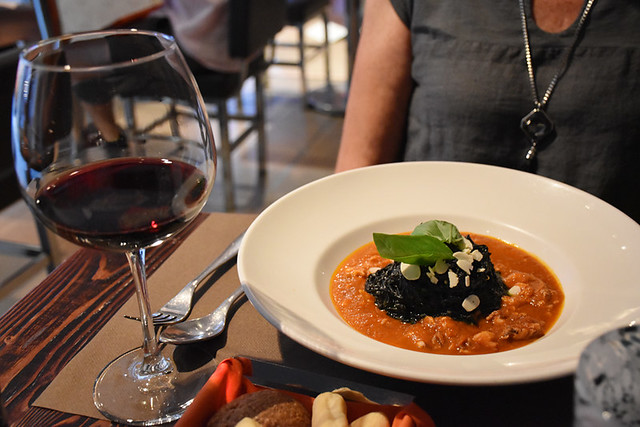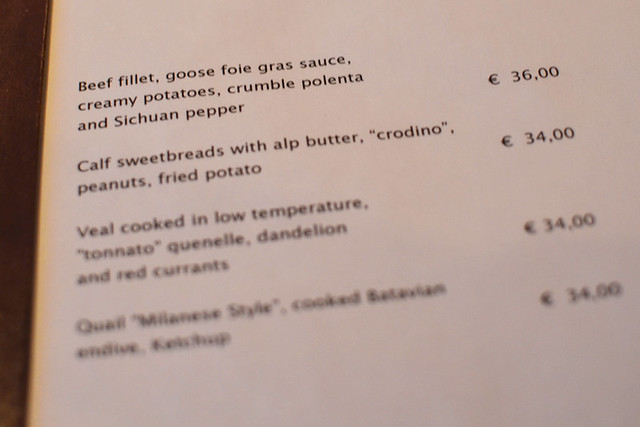The girl wears the simple yet sophisticated little black number with easy confidence, her beautifully conditioned hair glinting under the soft lighting as she flicks it back from her sculpted cheekbones. She sits down, back straight and knees together, and elegantly slides her legs under the table before crossing them neatly at the ankles. Her movements are fluid, yet considered. Her dining companion looks comfortable, but not quite as polished. Both are around mid 20s and more at ease than the baby boomer foursome at the table next to us.
They’re not uncomfortable as such, but there’s a stiffness to their behaviour at times. It’s a special night out. I know because I eavesdrop. The food is Michelin star standard and some of the more imaginative dishes are treated with caution. Like us, they’re people who have probably followed a curving arc when it comes to dining habits, progressing to more expensive restaurants in line with blossoming careers and subsequent increased spending power.

The waiting staff at The Three Chimneys on Skye are coolly professional. I say coolly because there’s a slight automaton aspect to service. Staff say all the right things and go into detail about the food; but in a fashion which comes across as a bit Downton Abbey. I prefer people to be themselves, maybe because we’re used to service in Spain and Portugal where there’s often more of a natural friendliness even in sophisticated restaurants. I like The Three Chimneys, but wish they’d lose the overuse of ‘sir’ and ‘madam’, it’s passé. Times have changed and so has the customer. Most of the people occupying tables around us are in their late 20s/early 30s.
Regulo, Puerto de la Cruz (2004)

We chose Regulo to treat Andy’s dad to a belated birthday meal because then it was the best restaurant in Puerto de la Cruz on Tenerife – lavishly decorated dining rooms set around the courtyard of a colonial town house on the edge of the town’s fishing district. Waiting staff wore formal attire and the food was what would have been called fine dining – a posher version of what was on other menus around the town. We discovered two things that night. One, always ask for a menu in the local lingo as well as one in English. What was described as fish pie in English, immediately catching Andy’s eye, turned out to be a cold, wobbly fish terrine. The second was, when it comes to dining out it’s horses for courses. Andy’s dad was clearly uncomfortable, and therefore unhappy, at dining in quite formal surroundings. The food was good but the setting wasn’t the right fit. He was far more at ease in the simpler traditional restaurants we’d eaten in during the week. Despite having a good job and a house in a relatively salubrious area of Stockport, he was of a working class generation not used to dining out on a regular basis.
Chapitô à Mesa, Lisbon (2017)

Our table was in a prime spot, looking over the terracotta Lisbon skyline to where the warm, golden sky was being dismantled by mauve brush strokes. My attention was drawn from the dreamy sunset scene to the chic interior and our fellow diners, nearly all of whom consisted of young couples. Watching them chat, laugh and instagram their food stirred up memories of our first holidays together. We’d set ourselves a daily budget and each night select the restaurant we could afford which appealed most. We didn’t have enough spends to be able to dine at the equivalent of a Chapitô à Mesa (starters average €10 and mains €20). We both had good jobs, but we were well into our careers before we could afford restaurants of that calibre. Thinking about our culinary travel experiences from 20 years previously whilst observing other diners piqued my interest. I’ve an interest in sociological patterns, and there seemed to be one here.
Impronta Cafe, Venice (2018)

After Chapitô in Lisbon I noted more and more a shift in dining demographics whenever we ate out. In our limited experience in Venice I’d say a good dining experience featuring cuisine prepared and presented with some flair is going to set you back around €100. The equivalent amount would have had us instantly dismissing Impronta Cafe as a potential eating venue when we were the age of the majority of the diners around us. Our first forays into ‘good’ restaurants were of feeling slightly out of place amongst a much older clientele. In many good restaurants we’ve eaten in over the last couple of years, including Impronta in Venice, it seemed to me that demographic imbalance been turned on its head.

So far, so anecdotal – a series of observations from our dining experiences in various destinations. This year a few publications published articles about the changes in eating patterns between generations. A survey carried out by Bernstein Research analysts found that those who make up Generation Y (born between 1981 and the mid 2000s) were likely to spend less time in the kitchen preparing food and more time eating out. According to the research, Generation Y eats out in restaurants far more than any other previous generation.
In Sado, Setúbal (2018)

In Sado was selected because we thought it would be a safe choice. It’s friendly and homely without being dated (despite retro memorabilia). The menu features mainly petiscos (Portuguese tapas) so we can pick a selection which includes crowd-pleasers as well as a couple of new flavours for my mum to try. Mackerel pâté goes down well; potato skins with sour cream dip prompt a lukewarm response; gratinated scallops are given a thumbs down; we knew the choco frito would be too ‘out there’ but we fancied some fried cuttlefish; mushrooms with quail eggs are a hit; and she says she likes the pataniscas (salt cod patties) but I’m not sure. As we end the meal with salted caramel cheesecake my mum remarks “there are no old people in this restaurant, only young ones.”
I look at the other diners. Behind me is a couple in their 60s. In one corner is a family, the oldest of whom might be 70. The average age of the rest is somewhere between 30 and 50. We’re certainly not what could be considered young. I suspect what my mum might really be saying is it’s not a place she feels particularly comfortable in.

We’re lucky, there are no restaurants where we feel uncomfortable. Over time, and with lots of practice, we became far more relaxed eating out than our parents ever could. For the generation after ours it’s second nature.




Be the first to comment